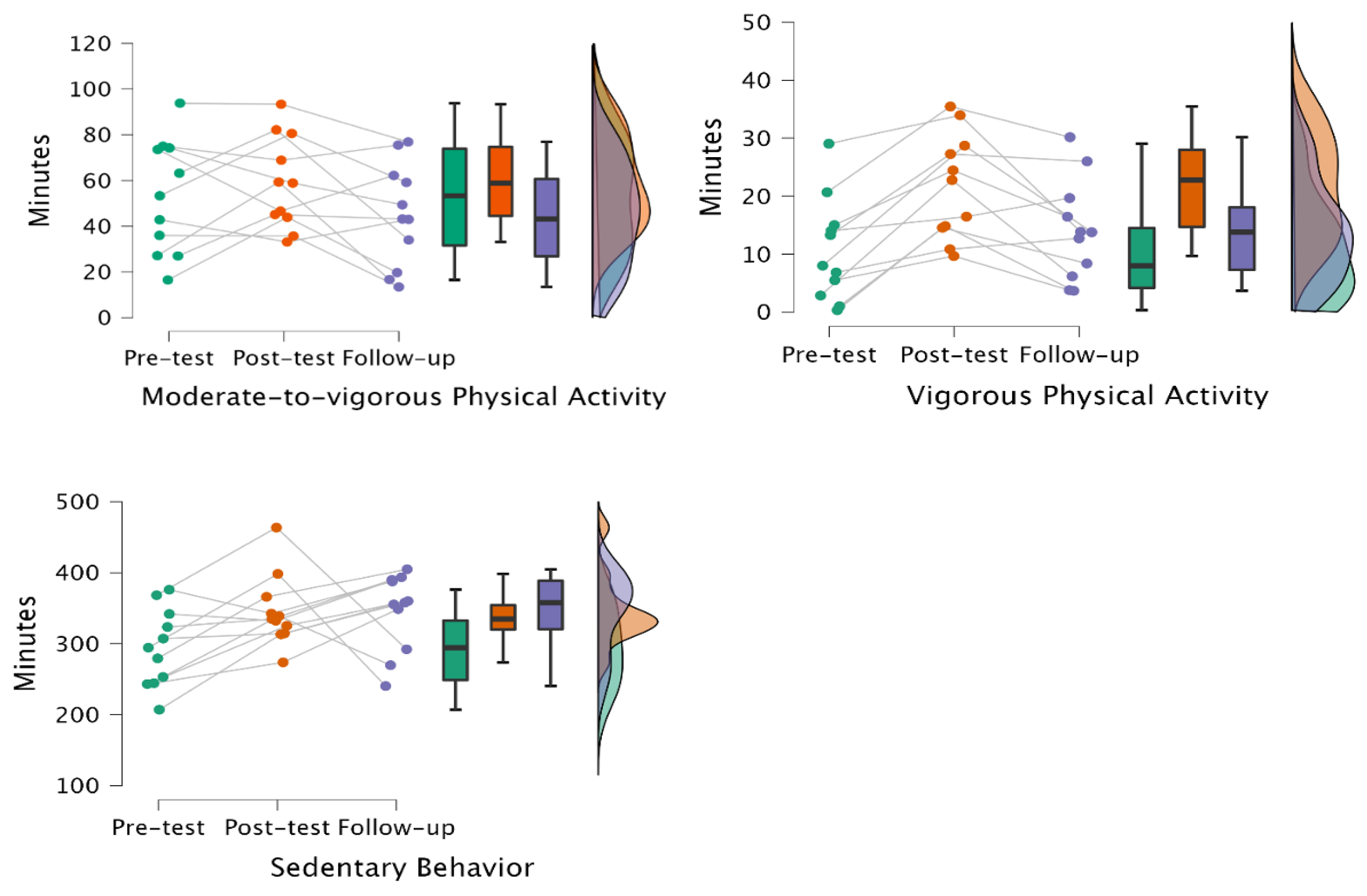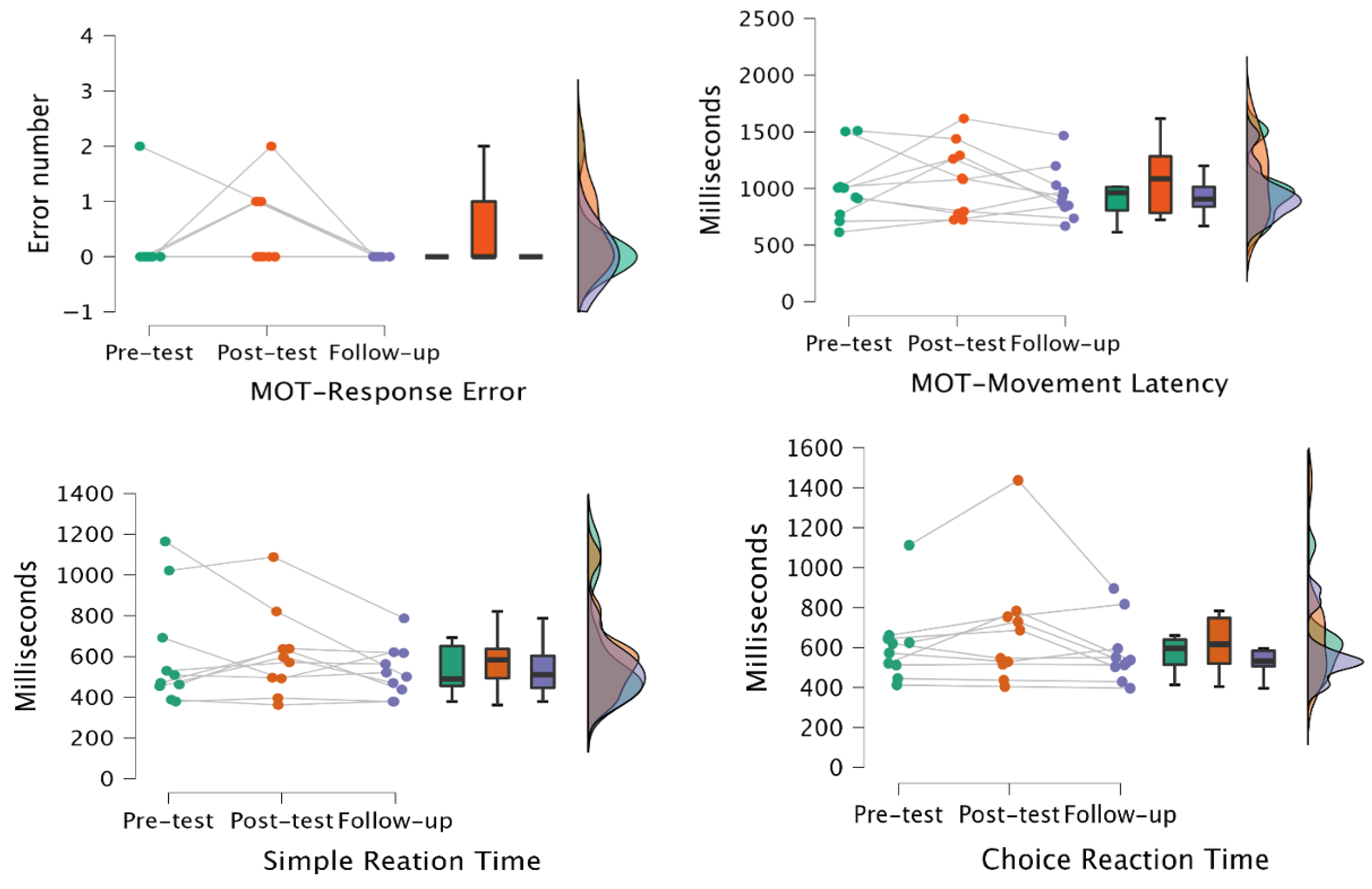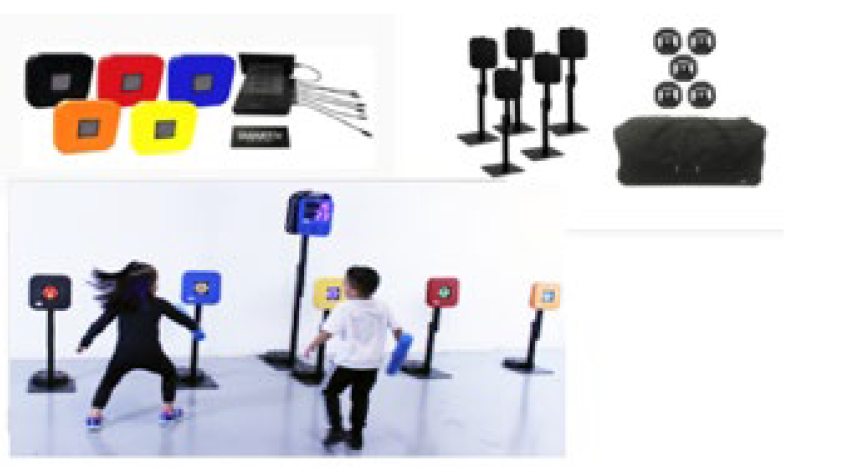Effect of the Virtual Reality-Infused Movement and Activity Program (V-MAP) on Physical Activity and Cognition in Head Start Preschoolers
Abstract
Highlights
- •
- V-MAP significantly increased vigorous physical activity by 10 min per day during the school day.
- •
- V-MAP did not result in significant immediate cognitive gains, but delayed effects were seen at one-month follow-up.
- •
- Implementing V-MAP in recess may help Head Start preschoolers achieve or accumulate the recommended daily 60-minute MVPA guideline.
- •
- VR-based physical activity for as little as 30 min per day may benefit cognitive capability.
Abstract
1. Introduction
2. Materials and Methods
2.1. Participants
2.2. Study Design
2.3. Virtual Reality-Infused Movement and Activity Program (V-MAP)
2.4. Assessment of Physical Activity and Sedentary Behavior
2.5. Assessment of Cognitive Function
2.6. Statistical Analyses
3. Results
3.1. Overall Child Adherence and PedometerResults
3.2. V-MAP Effects on Physical Activity
3.3. V-MAP Effects on Cognitive Function
4. Discussion
5. Conclusions
Author Contributions
Funding
Institutional Review Board Statement
Informed Consent Statement
Data Availability Statement
Acknowledgments
Conflicts of Interest
References
- Liu, T.; Hamilton, M.; Smith, S. Motor Proficiency of the Head Start and typically developing children on MABC-2. J. Child. Adolesc. Behav. 2015, 3, 198. [Google Scholar] [CrossRef]
- Goodway, J.D.; Robinson, L.E.; Crowe, H. Gender differences in fundamental motor skill development in disadvantaged preschoolers from two geographical regions. Res. Q. Exerc. Sport. 2010, 81, 17–24. [Google Scholar] [CrossRef] [PubMed]
- Guram, S.; Heinz, P. Media use in children: American Academy of Pediatrics recommendations. Arch. Dis. Child. Educ. Pract. Ed. 2018, 103, 99–101. [Google Scholar] [CrossRef]
- Piercy, K.L.; Troiano, R.P.; Ballard, R.M.; Carlson, S.A.; Fulton, J.E.; Galuska, D.A.; George, S.M.; Olson, R.D. The physical activity guidelines for Americans. JAMA 2018, 320, 2020–2028. [Google Scholar] [CrossRef] [PubMed]
- Cliff, D.P.; Mcneill, J.; Vella, S.A.; Howard, S.J.; Santos, R.; Batterham, M.; Melhuish, E.; Okely, A.D.; de Rosnay, M. Adherence to 24-hour movement guidelines for the early years and associations with social-cognitive development among Australian preschool children. BMC Public Health 2017, 17, 207–215. [Google Scholar] [CrossRef] [PubMed]
- Boyle, C.A.; Boulet, S.; Schieve, L.A.; Cohen, R.A.; Blumberg, S.J.; Yeargin-Allsopp, M.; Visser, S.; Kogan, M.D. Trends in the prevalence of developmental disabilities in US children, 1997–2008. Pediatrics 2011, 127, 1034–1042. [Google Scholar] [CrossRef]
- Joshi, P.; Geronimo, K.; Acevedo-Garcia, D. Head Start since the war on poverty: Taking on new challenges to address persistent school readiness gaps. J. Appl. Res. Child. Inf. Policy Child. Risk. 2016, 7, 11. [Google Scholar] [CrossRef]
- Mahar, M.T. Impact of short bouts of physical activity on attention-to-task in elementary school children. Prev. Med. 2011, 51, S60–S64. [Google Scholar] [CrossRef]
- Barr-Anderson, D.J.; Auyong, M.; Whitt-Glover, M.C.; Glenn, B.A.; Yancey, A.K. Integration of short bouts of physical activity into organizational routine: A systematic review of the literature. Am. J. Prev. Med. 2011, 40, 76–93. [Google Scholar] [CrossRef]
- Wilson, A.N.; Olds, T.; Lushington, K.; Petkov, J.; Dollman, J. The impact of 10-minute activity breaks outside the classroom on male students’ on-task behaviors and sustained attention: A randomized crossover design. Acta Paediatr. 2016, 105, e181–e188. [Google Scholar] [CrossRef]
- Bellows, L.L.; Davies, P.L.; Anderson, J.; Kennedy, C. Effectiveness of a physical activity intervention for Head Start preschoolers: A randomized intervention study. Am. J. Occup. Ther. 2013, 67, 28–36. [Google Scholar] [CrossRef]
- Palmer, K.K.; Matsuyama, A.L.; Robinson, L.E. Impact of structured movement time on preschooler’ physical activity engagement. Early Child. Educ. J. 2017, 45, 201–206. [Google Scholar] [CrossRef]
- Wadsworth, D.D.; Jonson, J.L.; Carroll, A.V.; Pangelinan, M.M.; Rudisill, M.E.; Sassi, J. Intervention strategies to elicit MVPA in preschoolers during outdoor play. Int. J. Environ. Res. Public Health 2020, 17, 650. [Google Scholar] [CrossRef] [PubMed]
- Chen, S.; Gu, X. Toward active living: Comprehensive school physical activity program research and implications. Quest. 2018, 70, 191–212. [Google Scholar] [CrossRef]
- Zhang, X.; Gu, X.; Chu, T.L.; Lee, J.; Zhang, T. Weight Status and Socio-Demographic Disparities in Children’s Physical Activity Intensity during Different Segments of the School Day. Elem. Sch. J. 2024, 124, 499–512. [Google Scholar] [CrossRef]
- Carson, R.L.; Castelli, D.M.; Beighle, A.; Erwin, H. School-based physical activity promotion: A conceptual framework for research and practice. Child. Obes. 2014, 10, 100–106. [Google Scholar] [CrossRef]
- Wang, H.; Li, T.; Siahpush, M.; Chen, L.W.; Huberty, J. Cost-effectiveness of ready for recess to promote physical activity in children. J. Sch. Health 2017, 87, 278–285. [Google Scholar] [CrossRef]
- Hyndman, B.P.; Lester, L. The relationship between elementary school children’s enjoyment of school playground activities and participation in physical activity during lunchtime recess. Child. Youth Environ. 2015, 25, 80–99. [Google Scholar] [CrossRef]
- Pawlowski, C.S.; Anderson, H.B.; Troelsen, J.; Schipperijn, J. Children’s physical activity behavior during school recess: A pilot study using GPS, accelerometer, participant oberservation, and go-along interview. PLoS ONE 2016, 11, e0148786. [Google Scholar] [CrossRef]
- Barros, R.M.; Silver, E.J.; Stein, R.E.K. School recess and group classroom behavior. Pediatrics 2009, 123, 431–436. [Google Scholar] [CrossRef]
- Ramstetter, C.L.; Murray, R.; Garner, A.S. The crucial role of recess in schools. J. Sch. Health 2010, 80, 517–526. [Google Scholar] [CrossRef] [PubMed]
- Stapp, A.C.; Karr, K.J. Effect of recess on fifth grade students’ time on-task in an elementary classroom. Int. Electron. J. Elem. Educ. 2018, 10, 449–456. [Google Scholar] [CrossRef]
- Russ, L.B.; Webster, C.A.; Beets, M.W.; Egan, C.; Weaver, R.G.; Harvey, R.; Phillips, D.S. Development of the system for observing student movement in academic routines and transitions (SOSMART). Heal. Educ. Behav. 2017, 44, 304–315. [Google Scholar] [CrossRef] [PubMed]
- Gao, Z.; Zeng, N.; Pope, Z.C.; Wang, R.; Yu, F. Effects of exergaming on motor skill competence, perceived competence, and physical activity in preschool children. J. Sport Health Sci. 2020, 9, 472–479. [Google Scholar]
- Jones, D.J. Future directions in the design, development, and investigation of technology as a service delivery vehicle. Clin. Child. Adolesc. Psychol. 2014, 43, 128–142. [Google Scholar] [CrossRef]
- Gu, X.; Fu, Y.; Chen, W.; Tamplain, M.P.; Zhang, T.; Wang, J. A causal pathway of physical activity to motor competence in childhood: Evidence from a school-based intervention. J. Sports Sci. 2021, 39, 460–468. [Google Scholar] [CrossRef]
- Fu, Y.; Burns, R.D.; Constantino, N.; Zhang, P. Differences in step counts, motor competence, and enjoyment between an exergaming group and a non-exergaming group. Games Heal. J. 2017, 7, 335–340. [Google Scholar] [CrossRef]
- Mantilla, A.; Edwards, S. Digital technology use by and with young children: A systematic review for the statement on young children and digital technologies. Australas. J. Early Child. 2019, 44, 182–195. [Google Scholar] [CrossRef]
- Yamada-Rice, D.; Mushtaq, F.; Woodgate, A.; Bosmans, , D.; Douthwaite, , A.; Douthwaite, , I.; Harris, W.; Holt, R.; Kleeman, D.; Marsh, J.; et al. Children and Virtual Reality: Emerging Possibilities and Challenges. 2017. Available online: https://researchonline.rca.ac.uk/3553/1/Yamada-Rice%20CVR%202017.pdf (accessed on 10 September 2025).
- Bailey, J.O.; Bailenson, J.N. Immersive virtual reality and the developing child. In Cognitive Development in Digital Contexts; Academic Press: Cambridge, MA, USA, 2017; pp. 181–200. [Google Scholar] [CrossRef]
- Bailey, B.W. Energy cost of exergaming. Arch. Pediatr. Adolesc. Med. 2011, 165, 597–602. [Google Scholar] [CrossRef]
- Pate, R.P.; Almeida, M.J.; McIver, K.L.; Pfeiffer, K.A.; Dowda, M. Validation and calibration of an accelerometer in preschool children. Obesity 2006, 14, 2000–2006. [Google Scholar] [CrossRef]
- Butte, N.F.; Wong, W.W.; Lee, S.J.; Adolph, A.L.; Puyau, M.R.; Zakeri, I.F. Prediction of energy expenditure and physical activity in preschoolers. Med. Sci. Sports Exerc. 2014, 46, 1216–1226. [Google Scholar] [CrossRef] [PubMed]
- Fried, R.; Hirshfeld-Becker, D.; Petty, C.; Batcheider, H.; Biederman, J. How informative is the CANTAB to assess executive functioning in children with ADHD? A controlled study. J. Atten. Disord. 2015, 19, 468–475. [Google Scholar] [CrossRef]
- Cohen, J. Statistical Power Analysis for the Behavioral Sciences; Routledge: New York, NY, USA, 2013; 459p. [Google Scholar]
- Pagels, P.; Boldemann, C.; Raustorp, A. Comparison of pedometer and accelerometer measure of physical activity during preschool time on 3- to 5-year-old children. Acta Paediatr. 2011, 100, 116–120. [Google Scholar] [CrossRef] [PubMed]
- Colin Bell, A.; Finch, M.; Wolfenden, L.; Fitzgerald, M.; Morgan, P.J.; Jones, J.; Freund, M.; Wiggers, J. Child physical activity levels and associations with modifiable characteristics in cetre-based childcare. Aust. N. Z. J. Public Health 2015, 39, 232–236. [Google Scholar] [CrossRef] [PubMed]
- Adams, M.A.; Johnson, W.D.; Tudor-Locke, C. Steps/day translation of the moderate-to-vigorous physical activity guideline for children and adolescents. Int. J. Behav. Nutr. Phys. Act. 2013, 10, 49. [Google Scholar] [CrossRef]
- Tudor-Locke, C.; Craig, C.L.; Beets, M.W.; Belton, S.; Cardon, G.M.; Duncan, S.; Hatano, Y.; Lubans, D.R.; Olds, T.S.; Raustorp, A.; et al. How many steps/day are enough? For children and adolescents. Int. J. Behav. Nutr. Phys. Act. 2018, 8, 78. [Google Scholar] [CrossRef]
- Owens, S.; Galloway, R.; Gutin, B. The case for vigorous physical activity in youth. Am. J. Lifestyle Med. 2017, 11, 96–115. [Google Scholar] [CrossRef]
- Laguna, M.; Ruiz, J.R.; Lara, M.T.; Aznar, S. Recommended levels of physical activity to avoid adiposity in Spanish children. Pediatr. Obes. 2013, 8, 62–69. [Google Scholar] [CrossRef]
- Sayers, A.; Mattocks, C.; Deere, K.; Ness, A.; Riddoch, C.; Tobias, J.H. Habitual levels of vigorous, but not moderate or light, physical activity is positively related to cortical bone mass in adolescents. J. Clin. Endocrinol. Metab. 2011, 96, E793–E802. [Google Scholar] [CrossRef]
- Hay, J.; Maximova, K.; Durksen, A.; Carson, V.; Rinaldi, R.L.; Torrance, B.; Ball, G.D.C.; Majumdar, S.R.; Plotnikoff, R.C.; Veugelers, P.; et al. Physical activity intensity and cardiometabolic risk in youth. Arch. Pediatr. Adolesc. Med. 2012, 166, 1022–1029. [Google Scholar] [CrossRef]
- Podulka Coe, D.; Pivamik, J.M.; Womack, C.J.; Reeves, M.J.; Malina, R.M. Effect of physical education and activity elvels on academic achievement in children. Med. Sci. Sports Exerc. 2006, 38, 1515–1519. [Google Scholar] [CrossRef]
- Taylor, R.W.; Williams, S.M.; Farmer, V.L.; Taylor, B.J. Changes in physical activity over time in young children: A longitudinal study using accelerometers. PLoS ONE 2013, 8, e81567. [Google Scholar] [CrossRef]
- Costigan, S.A.; Lubans, D.R.; Lonsdale, C.; Sanders, T.; del Pozo Cruz, B. Associations between physical activity intensity nd well-being in adolescents. Prev. Med. 2019, 125, 55–61. [Google Scholar] [CrossRef]
- Harner, M.; Stamatakis, E. Relative proportion of vigorous physical activity, total volume of moderate to vigorous activity, and body mass index in youth: The millennium cohort study. Int. J. Obes. 2018, 42, 1239–1242. [Google Scholar] [CrossRef] [PubMed]
- Jones, D.; Innerd, A.; Giles, E.L.; Azevedo, L.B. Association between fundamental motor skills and physical activity in the early years: A systematic review and meta-analysis. J. Sport. Health Sci. 2020, 9, 542–552. [Google Scholar] [CrossRef] [PubMed]
- Kuzik, N.; Naylor, P.J.; Spence, J.C.; Carson, V. Movement behaviours and physical, cognitive, and social-emotional development in preschool-aged children: Cross-sectional associations using compositional analyses. PLoS ONE 2020, 15, e0237945. [Google Scholar] [CrossRef]
- Tandon, P.S.; Zhou, C.; Sallis, J.F.; Cain, K.L.; Frnak, L.D.; Saelens, B.E. Home environment relationships with children’s physical activity, sedentary time, and screen time by socioeconomic status. Int. J. Behav. Nutr. Phys. Act. 2012, 9, 88. [Google Scholar] [CrossRef]
- Pate, R.R.; Pfeiffer, K.A.; Trost, S.G.; Ziegler, P.; Dowda, M. Physical activity among children attending preschools. Pediatrics 2004, 114, 1258–1263. [Google Scholar] [CrossRef]
- Leckey, S.; Selmeczy, D.; Kazemi, A.; Johnson, E.G.; Hembacher, E.; Ghetti, S. Response latencies and eye gaze provide insight on how toddlers gather evidence under uncertainty. Nat. Hum. Behav. 2020, 4, 928–936. [Google Scholar] [CrossRef]
- Erickson, K.I.; Hillman, C.H.; Kramer, A.F. Physical activity, brain, and cognition. Curr. Opin. Behav. Sci. 2015, 4, 27–32. [Google Scholar] [CrossRef]
- Chatzihidiroglou, P.; Chatzopoulos, D.; Lykesas, G.; Doganis, G. Dancing effects on preschools’ sensorimotor synchronization, balance, and movement reaction time. Percept. Mot. Skills 2018, 125, 463–477. [Google Scholar] [CrossRef]
- Lee, J.; Zhang, T.; Chu, T.L.; Gu, X.; Zhu, P. Effects of a fundamental motor skill-based afterschool program on children’s physical and cognition health outcomes. Int. J. Environ. Res. Public Health 2020, 17, 733. [Google Scholar] [CrossRef]
- Antão, J.Y.F.D.L.; Abreu, L.C.D.; Barbosa, R.T.D.A.; Crocetta, T.B.; Guarnieri, R.; Massetti, T.; Antunes, T.P.C.; Tonks, J.; de Mello Monteiro, C.B. Use of augmented reality with a motion-controlled game utilizing alphabet letters and numbers to improve performance and reaction time skills for people with autism spectrum disorder. Cyberpsychol. Behav. Soc. Netw. 2020, 23, 16–22. [Google Scholar] [CrossRef]
- Pourazar, M.; Mirakhori, F.; Hemayattalab, R.; Bagherzadeh, F. Use of virtual reality intervention to improve reaction time in children with cerebral palsy: A randomized controlled trial. Dev. Neurorehabil. 2018, 21, 515–520. [Google Scholar] [CrossRef] [PubMed]
- Amprasi, E.; Vernadakis, N.; Zetou, E.; Antoniou, P. Effect of a full immersive virtual reality intervention on selective attention in children. Int. J. Instr. 2022, 15, 565–582. [Google Scholar] [CrossRef]
- Adamo, K.B.; Rutherford, J.A.; Goldfield, G.S. Effects of interactive video game cycling on overweight and obese adolescent health. Games Health J. 2010, 1, 29–36. [Google Scholar] [CrossRef] [PubMed]
- Eng, C.M.; Thiessen, E.D.; Fisher, A.V. A literature review on the effects of exergames on executive function in youth. Technol. Mind Behav. 2023, 4, 10-1037. [Google Scholar]
- Vernadakis, N.; Papastergiou, M.; Zetou, E.; Antoniou, P. The impact of exergames on fundamental motor skills and cognitive function of kindergarten children. Comput. Educ. 2015, 83, 90–102. [Google Scholar] [CrossRef]


| SMARTfitTM Games | SMARTfitTM Game Descriptions | FMS Integration with SMARTfitTM Play Pods |
|---|---|---|
| Track the Targets—Dice color and shapes |
|  FMS Integration
Lesson Plan Sequence
Note: Implement 2–3 skills/session within 2–3 SMARTfitTM game |
| ||
| ||
| Knock the Lights Out |
| |
| ||
| Track the Letters and Numbers |
| |
| ||
| Seek the Smiley Face, Color, Letter |
|
| Variables | Pre-Test (T1) | Post-Test (T2) | Follow-Up (T3) | T2 vs. T1 | T2 vs. T3 | T3 vs. T1 |
|---|---|---|---|---|---|---|
| M(SD) | M(SD) | M(SD) | d | d | d | |
| MVPA | 52.97 (24.90) | 58.89 (20.17) | 44.83 (22.43) | 0.32 | 0.76 | −0.44 |
| VPA | 10.59 (8.85) | 21.72 (9.04) | 14.06 (8.66) | 1.56 | 1.08 | 0.49 |
| SB | 294.36 (54.85) | 345.66 (50.04) | 345.38 (54.47) | 0.71 | 0.004 | 0.71 |
| Simple RT | 607.1 (272.49) | 609.75 (213.55) | 527.5 (125.45) | 0.01 | 0.45 | −0.45 |
| Choice RT | 612.55 (194.65) | 682.25 (297.04) | 576.2 (159.32) | 0.48 | 0.73 | −0.25 |
| Response Error | 0.2 (0.63) | 0.5 (0.71) | 0 (0) | 0.41 | 0.69 | −0.28 |
| Movement Latency | 996.44 (300.47) | 1080.27 (319.49) | 957.1 (232.76) | 0.29 | 0.43 | −0.14 |
Disclaimer/Publisher’s Note: The statements, opinions and data contained in all publications are solely those of the individual author(s) and contributor(s) and not of MDPI and/or the editor(s). MDPI and/or the editor(s) disclaim responsibility for any injury to people or property resulting from any ideas, methods, instructions or products referred to in the content. |
© 2025 by the authors. Licensee MDPI, Basel, Switzerland. This article is an open access article distributed under the terms and conditions of the Creative Commons Attribution (CC BY) license (https://creativecommons.org/licenses/by/4.0/).
Share and Cite
Gu, X.; Moss, S.; Zhang, X.; Zhang, T.; Greer, T.L. Effect of the Virtual Reality-Infused Movement and Activity Program (V-MAP) on Physical Activity and Cognition in Head Start Preschoolers. Children 2025, 12, 1228. https://doi.org/10.3390/children12091228
Gu X, Moss S, Zhang X, Zhang T, Greer TL. Effect of the Virtual Reality-Infused Movement and Activity Program (V-MAP) on Physical Activity and Cognition in Head Start Preschoolers. Children. 2025; 12(9):1228. https://doi.org/10.3390/children12091228
Chicago/Turabian StyleGu, Xiangli, Samantha Moss, Xiaoxia Zhang, Tao Zhang, and Tracy L. Greer. 2025. "Effect of the Virtual Reality-Infused Movement and Activity Program (V-MAP) on Physical Activity and Cognition in Head Start Preschoolers" Children 12, no. 9: 1228. https://doi.org/10.3390/children12091228
APA StyleGu, X., Moss, S., Zhang, X., Zhang, T., & Greer, T. L. (2025). Effect of the Virtual Reality-Infused Movement and Activity Program (V-MAP) on Physical Activity and Cognition in Head Start Preschoolers. Children, 12(9), 1228. https://doi.org/10.3390/children12091228








